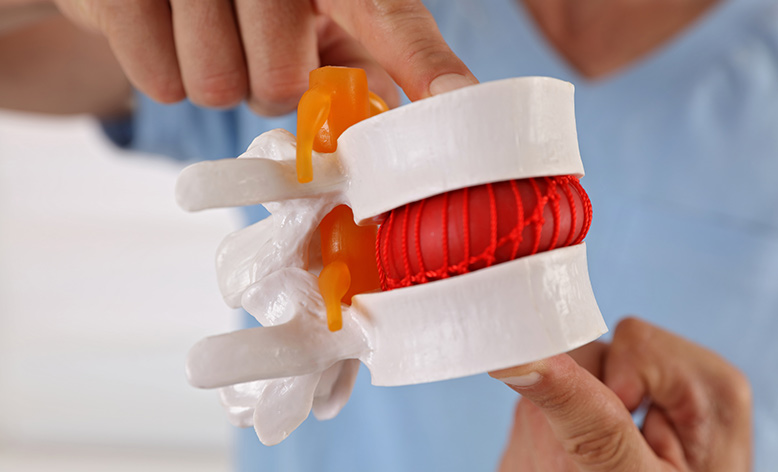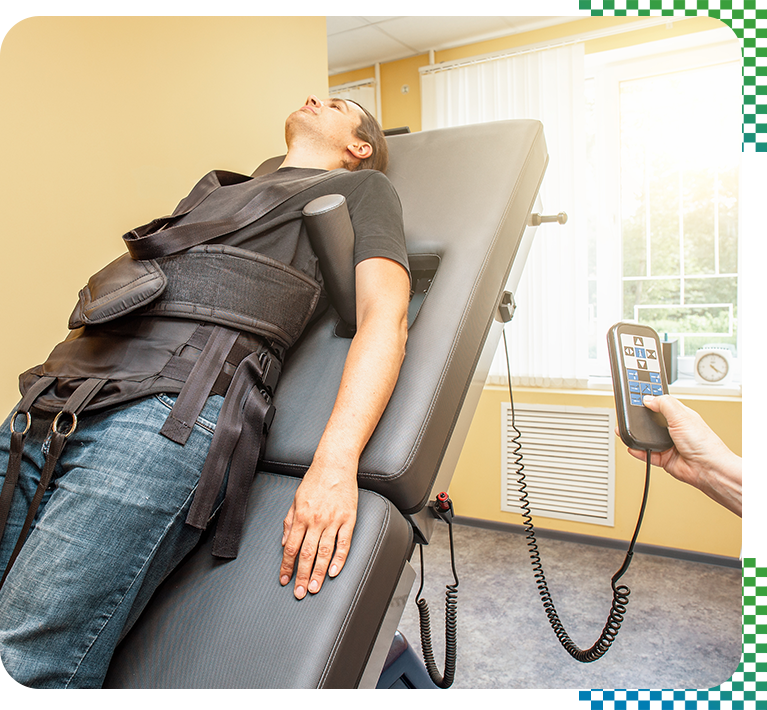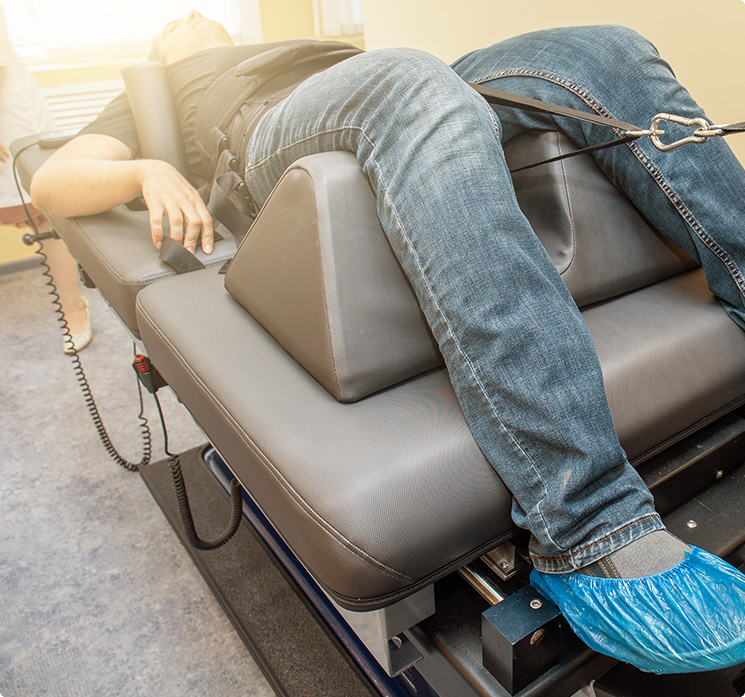Could you imagine going through life every day with near-debilitating, chronic back pain? Back pain is one of the most common ailments in America - it's estimated that 8% of all adults, or 16 million people, suffer from chronic back pain in the U.S. every year. If you've never experienced a back injury or pain, be thankful. Chronic back pain affects every aspect of a person's life, from participating in sports to limitations with everyday activities, like cooking dinner. In fact, many people with chronic back pain can't even make a reliable living and put food on the table. Almost 83 million workdays are lost every year due to choric back pain.

The inability to work and provide isn't just a physical issue - it can become an emotional one too. Many people suffering from chronic back pain also suffer from depression and anxiety. Unfortunately, in the past, chronic back pain sufferers wanting to avoid addictive medications and invasive surgeries had few viable relief options. However, if you're suffering from a chronic back issue like sciatica, a pinched nerve, or a bulging disc, pain relief may be closer than you think.
Modern chiropractic care and, more specifically, a spinal decompression chiropractor in Charleston, SC, may be the long-term solution you need for chronic back pain.
A common misconception is that chiropractors only adjust your back and neck when, in fact, they treat the whole body with all-natural treatments. Here at Elite Healthcare, our doctors focus on your overall health, not just pain. We want to find and address the underlying causes of your symptoms. If you're unfamiliar with an integrative approach to medicine, this strategy may seem new. Our chiropractic care is less about putting a band-aid on the problem and more about finding a natural, long-term solution to your pain.
Fortunately, our experienced chiropractors provide the best in natural pain relief. Prescription and over-the-counter pain medications mask the symptoms you're experiencing versus getting to the cause of your pain. Pain is often the result of your spine being out of alignment, which leads to nerve issues. Once your spine is back in alignment, the nerves function correctly again.
Because our chiropractic center offers a combination of different therapies and non-surgical treatments, we provide a comprehensive approach to healing. Depending on the extent of your back problems, spinal decompression therapy may be the answer to your chronic pain problems.
Initially developed in 1985 by Dr. Allan Dyer, spinal decompression has been used by chiropractors for years. Unfortunately, spinal decompression is often passed over as a viable treatment, despite its numerous benefits.
In the past, patients suffering from chronic back pain issues like herniated discs were usually prescribed powerful medications. They were instructed to refrain from physical activities, referred to a physical therapist, and sent on their way. While physical therapy has an important role in back pain recovery, some back conditions need a more comprehensive treatment approach. For those patients, surgery seemed like the only option.
Today, patients with chronic back pain have many more options to consider. One of the most effective treatments for serious back pain is spinal decompression. This proven therapy, provided by Elite Healthcare, has been shown to significantly reduce pain and help patients live a normal, even active lifestyle once again.

Spinal decompression, also called Lumbar Cervical Decompression Therapy (LCD Therapy), is a very effective non-surgical solution to chronic back pain problems. If you're like most patients, your back pain is caused by disc issues related to your spine. This type of therapy uses computer technology and a spinal decompression machine in cityname, state, to stretch your spinal column slowly and gently, relieving abnormal pressure on the discs in your back, which sit in between your vertebrae.
This precise stretching action causes negative pressure to form inside the discs in your back, making them retract. With time, this negative pressure causes a reverse vacuum of sorts that actually draws your protruding discs into place. When pressure is removed from the disc segments in your spine, you experience much-needed pain relief.
The primary purpose of spinal decompression therapy is to provide you with immediate pain relief while creating a healthy environment to heal your spinal disc condition. Some of the most common conditions that spinal decompression therapy treats include:
This happens when spinal discs in your back are pushed outside of the spinal canal. When pushed outside of their usual space, these discs can put pressure on the nerves in your spine, resulting in localized pain and pain throughout your body. If a bulging disc is left untreated, it has a high chance of rupturing, which can necessitate surgery and longer recovery time.
Herniated discs are discs in your back that fracture or crack and leak fluid. The fluid or gel that leaks from a herniated disc may irritate the nerves in your back. When this happens, you may experience an intense burning sensation that shoots up and down your lower back and legs.
As you grow older, joints in your body, like your knees and hips, begin to wear away with time. The same thing can happen to the discs in your back. Often caused by heavy lifting or a family history of spine problems, degenerative discs are painful and can lead to serious situations. In advanced cases, bone spurs can form and affect the nerves of your spine.
When a herniated disc or bone spur begins to put pressure on the nerves in your back, it often causes sciatica. Sciatica is a common back problem that causes pain to radiate from your lower back down your legs via your sciatic nerve. Sometimes, this pain is only felt in one of your legs.
This condition is similar to arthritis of your spine, where the cartilage inside your facet joint breaks down and becomes inflamed. The result is often intense neck and back pain. It's most often caused by degenerative changes in the joints located between the bones of your spine.
This painful condition manifests when the space in your backbone is too small. When this happens, pressure impacts your spinal cord and the nerves that travel through it. Like other conditions treated by a spinal decompression therapy cityname, state, stenosis is caused by wear-and-tear in your back, which forms arthritis.
This term is often used to classify a range of back problems, most often caused by a pinched nerve root in your spinal column. This pinched nerve root may occur in different locations down your spine, like the lumbar or thoracic areas. Usually caused by a narrowing of the space where your nerve root leaves the spine, symptoms of this condition include pain, tingling, numbness, and weakness.
If you're looking for a safe way to relieve your chronic back pain, spinal decompression should be on your list of treatments to consider. This painless procedure is backed by research showing higher success rates in many patients when compared to spinal surgery. Unlike many medications, spinal decompression from Elite Healthcare Physical Medicine is designed to correct the condition you're facing while also minimizing costs and eliminating recovery and downtime.
Some of the most popular reasons why patients choose spinal decompression over surgery and other treatments include:
Invasive procedures, like back surgeries, often leave the patient racked with pain, long recovery times, and complications. Sometimes, the surgery doesn't work as intended, leaving the patient responsible for a therapy that didn't work correctly. As a non-invasive treatment, spinal decompression therapy can treat back and neck pain without needles, incisions, or harmful manipulations of the spine.

Getting back pain relief from surgery is far from guaranteed. However, because spinal decompression targets the underlying causes of your back pain, it's a much more effective long-term treatment. Spinal decompression is not a quick fix. When coupled with positive lifestyle changes like losing weight, you can maximize the pain-relieving benefits of spinal decompression.

Surgery of the back and spine requires the patient to be bedridden and uncomfortable for days and even weeks. Recovering from back surgery is no easy feat and often requires strong pain medications to help. Sometimes, back surgeries don't go as planned, causing complications and worse scenarios. Spinal decompression, on the other hand, is very effective and doesn't require much recovery time at all. Once your spinal decompression session is over, you'll probably be able to drive yourself home from our office.

One of the least talked about issues with back pain medications is that they only treat the pain, not the underlying causes. For many patients, relying on meds to relieve back pain fosters dependency on pain pills. Pain pill addiction is a very serious issue in the U.S., often leading patients down a dark path. With spinal decompression, you won't have to worry about taking pills for pain relief. That's because the root causes of your back pain are addressed, not just the symptoms.

If you were to look at the cost of surgery and subsequent years of prescription medication, you might be shocked. When compared to spinal decompression, surgery is a much more expensive treatment to consider. You've got to take the cost of surgery into account, but also the fact that you'll be forced to take time off work. By choosing spinal decompression therapy, you're choosing a safe, non-surgical treatment that doesn't require any time off work.

Spinal decompression relieves pressure on disrupted discs, causing them to retract back into place. This revolutionary treatment also lets oxygen, fluids, and nutrients re-enter your spinal discs, which provides additional healing.
 (843) 936-6238
(843) 936-6238

By now, you probably have a better idea of how spinal decompression can help rid your life of back pain. But spinal decompression treatment does more than help with bulging discs, herniated discs, arthritis, and more. It has also been shown to provide patients with important quality-of-life benefits.

As mentioned above, harsh surgeries leave you bedridden and unable to work for long periods of time. Spinal decompression allows you to jump right back into the workforce, so you can continue providing for your family. Plus, reducing your back pain naturally increases your mobility since you won't be stressing about hurting yourself while moving. Instead, you'll be living in the moment.
One of the worst symptoms affecting people with back pain is the inability to sleep well. Sleeping with back pain can be horrible, causing you to toss and turn to find a comfortable spot. As soon as you find one and get settled, your back starts to hurt again. It's a vicious cycle, but adjusting your spine and relieving pressure with spinal decompression will help you get a good night's rest.
Did you know that when your spine is decompressed, it helps fluids circulate throughout your body? These fluids actually flush your lymphatic system, which helps support your overall immune system. Better circulation also benefits your brain and can help boost concentration and memory. The improved circulation from spinal decompression may also distribute oxygen and nutrients to your skin, creating a multi-benefit effect.
We are happy to answer your questions, and help you find the services you need. Please message us to get started.
At Elite Healthcare Physical Medicine, we practice an integrated approach to pain relief and chiropractic care. Our goal is to restore your spine to its proper alignment, which speeds up your recovery time and prevents additional injuries. If chronic back pain has taken over your life, it's time to visit our chiropractic office for a thorough evaluation.
Ask yourself this: Have you been suffering from headaches and sleepless nights due to muscle strain? Is your ability to work and put food on the table compromised due to a pinched nerve? No amount of over-the-counter pain medication can provide a long-term fix for such an issue. Thankfully, our chiropractors have years of experience providing relief to patients just like yourself.
After a comprehensive exam, our doctor will create an individualized treatment plan tailored to your body. That way, we can address the full scope of your symptoms by correcting any root causes of your back pain.
From minor chiropractic adjustments to spinal decompression treatment, we'll find the solution that your back and body need to heal correctly. If you're ready to get back on the road to better health, we're here to help every step of the way. Contact our Elite Healthcare Physical Medicine today to get started.
 (843) 936-6238
(843) 936-6238
From The Bachelor Mansion to a sprawling Southern dream home!After getting engaged on Thursday’s ...
From The Bachelor Mansion to a sprawling Southern dream home!
After getting engaged on Thursday’s Golden Bachelor finale, Gerry Turner and Theresa Nist tell PEOPLE they plan to start their lives together in Charleston, South Carolina.
“One of the things that I think fate played a hand in is the possibility of where we might wind up living,” Gerry says. “For the last couple of years, when my family gets together, I've talked about moving to South Carolina, and it's an idea I've toyed with. And then in conversation with Theresa, a private moment, she's saying, ‘Well, yeah, my son lives near Charleston in South Carolina.’”
Gerry currently lives in Indiana and Theresa hails from New Jersey, but that conversation made it easy for the couple to decide where they should reside.
“And all of a sudden it's like, there's a big problem that is gone,” Gerry says. “The issue of compromising on where to live and how to reconcile families and all of that is, it's no longer an issue.”
The reality stars hope their families will visit often. “We want to have a house that's so inviting that everyone would want to come,” Theresa, 70, says. “Maybe a pool so they all want to come and have fun.”
Lucky for Gerry and Theresa, their kids have already bonded.
“Our daughters, they're like sisters now,” the father of two says.
Theresa agrees. “My daughter says, ‘Thank you for giving me two more sisters,’” the financial services professional says. “She has a sister-in-law already but now, two more sisters.”
After his hometown date with Theresa’s family, Gerry saw her family as his own.
“I looked at Jen and it was like, ‘This could be my own daughter,’” Gerry says of his fiancée’s daughter. “ I literally was having those thoughts because she was so kind and she was so sensitive to the situation, to her mom and to me. The whole dynamic just worked.”
Theresa and Gerry plan to bring their families together to celebrate Hanukkah this month. “We'll have a holiday dinner together with everyone,” Gerry says.
As they’ve continued getting to know each other over phone calls and text messages these last few months, Gerry and Theresa learned they share similar views on one very important — albeit unromantic — facet of combining their lives.
“Financially, we're the same,” Gerry says. “The way we handle money is the same.”
Theresa clarifies that that means the pair consider themselves “somewhat frugal.”
While Gerry and Theresa look forward to moving in together, they don’t have an exact plan for when that will happen.
“We've had conversations and we've narrowed it down to a time window, but that's always in flux,” the retired restaurateur says. “We have two homes to sell. We have other events that we're going to have to deal with and so forth.”
One major event: their live, televised wedding that will air on ABC in January.
“When you're in your 20s and you put something off for a year, it's a very small percentage of your life,” Gerry says. “In your 70s, the clock ticks faster. And I'm 100% certain I found the right girl for me. So it's like, why not?”
Gerry can’t wait for his future to unfold, but Theresa keeps him grounded.
“Fortunately, Theresa is the more patient, I think, of the two of us,” he says. “Me, I'm like, ‘Come on, let's go, it's time to go have fun. Life's a wasting. Let's go.’”
Never miss a story — sign up for PEOPLE's free daily newsletter to stay up-to-date on the best of what PEOPLE has to offer, from juicy celebrity news to compelling human interest stories.
The Golden Wedding will air Jan. 4 at 8 p.m. ET on ABC.
GEORGETOWN, S.C. (AP) — An intense late-year storm barreled up the East Coast on Sunday with heavy rains and strong winds that shattered rainfall records, forced water rescues from flooded streets and washed out holiday celebrations.Authorities rescued dozens of motorists stranded by floodwaters in South Carolina’s waterfront community of Georgetown, Georgetown County spokesperson Jackie Broach said. Mo...
GEORGETOWN, S.C. (AP) — An intense late-year storm barreled up the East Coast on Sunday with heavy rains and strong winds that shattered rainfall records, forced water rescues from flooded streets and washed out holiday celebrations.
Authorities rescued dozens of motorists stranded by floodwaters in South Carolina’s waterfront community of Georgetown, Georgetown County spokesperson Jackie Broach said. More than 9 inches (22.9 centimeters) of rain fell in the area situated between Charleston and Myrtle Beach since late Saturday.
“It’s not just the areas that we normally see flooding, that are flood-prone,” Broach said. “It’s areas that we’re not really expecting to have flooding issues...It’s like a tropical storm, it just happens to be in December.”
The tide in Charleston Harbor hit its fourth highest level on record and was “well above the highest tide for a non-tropical system,” according to the National Weather Service.
Other news
Slow-moving Pacific storm threatens to bring California flooding and mudslides
Christmas is in jeopardy for some New Englanders after storms and flooding knocked out power
Northeastern US mops up ahead of holidays after deadly storm slams the region, killing at least 5
Rising sea levels driven by human-caused climate change mean even relatively weak weather systems can now produce storm surges previously associated with hurricanes, said Meteorologist Jeff Masters, co-founder of the Weather Underground. In South Carolina that’s worsened by natural subsidence along the coast.
By 2050, Charleston is expected to see another 14 inches (35.6 centimeters) of sea level rise, Masters said.
“In Charleston, this is the sixth time this year already that they’ve had a major coastal flood. Most of those would not have been major flooding 100 years ago, because the sea level has risen that much,” he said.
The storm was forecast to gain strength as it tracked along the Georgia and Carolina coasts, producing heavy rain and gusty winds before sweeping into New England by Monday morning, the weather service said. Wind gusts of 35 mph to 45 mph (56 kph to 72 kph) could bring down trees, especially on saturated ground.
There were numerous road closures in Charleston and across South Carolina’s Lowcountry, while stranded cars littered streets.
There were no reports of injuries or deaths in Georgetown County, Broach said. Gusty winds were strong enough to topple some signs and trees. Outdoor holiday decorations were tossed about, she said.
Water rescues also took place on Kiawah and Seabrook islands, according to media outlets.
Charleston International Airport had more than 3 inches (8 centimeters) of rain in 24 hours — almost five times the prior record set in 1975, according to the National Weather Service.
Farther up the coast, minor to moderate coastal flooding was expected Sunday, according to the National Weather Service office in Wilmington, North Carolina.
There were more than 31,000 power outages in South Carolina, according to PowerOutage.us, along with over 14,000 in North Carolina and more than 11,000 in Florida.
New York Gov. Kathy Hochul warned of a possible 2 to 4 inches (5.1 to 10.2 centimeters) of rain, powerful winds and potential flooding in parts of the state. Flood watches were in effect in many locations in New York City, and high wind warnings were activated around the city and Long Island.
“We will get through this storm, but preparation is the key,” New York Mayor Eric Adams said. City officials told residents to expect several hours of rain and possible delays during Monday morning’s commute.
Colder air behind the storm will trigger lake-effect snow across the Great Lakes toward the Appalachians and upstate New York into Tuesday, the weather service said.
The storm dumped up to 5 inches (12.7 centimeters) of rain across Florida, inundating streets and forcing the cancellation of boat parades and other holiday celebrations.
The National Weather Service issued flood warnings and minor flooding advisories for a wide swath of the state, from the southwest Gulf Coast to Jacksonville. Major airports remained open, however, at the start of the busy holiday travel season.
“Today is not the day to go swimming or boating!” Sheriff Carmine Marceno of Lee County, on Florida’s southwestern coast, said on X, formerly known as Twitter.
Coastal advisories were issued for much of Florida as strong winds churned waters in the Gulf and along the north Atlantic coast.
The storm could be good news for residents in southwest Florida who have been facing water restrictions and drought conditions heading into what normally is the region’s dry season.
The weather service also warned of 2 to 4 inches (5.1 to 10.2 centimeters) of rain in parts of Pennsylvania, New Jersey and Delaware, with the heaviest expected late Sunday night, and possible urban and small stream flooding and at least minor flooding to some rivers through Monday.
Forecasters also warned of strong winds in coastal areas, gale-force winds offshore, and moderate coastal flooding along Delaware Bay and widespread minor coastal flooding elsewhere.
The weather service said there is a slight risk of excessive rainfall over parts of New England through Monday morning, with the potential for flash flooding. Northern New England is expected to get the heaviest rain Monday through Tuesday morning.
It’s hard not to have a good meal out in Charleston. From indulgent fine dining restaurants to delightful little coffee shops, the city spoils its residents with good food and drinks. We polled our staffers and writers for their best bites and sips of the year. Here’s what stood out:Shrimp ceviche at Pink CactusThe shrimp ceviche on crispy tostadas at Pink Cactus is so good! Every bite is perfect and has a spicy kick to it.Bexley surfboard at Bexley Fish & Raw BarBexley in Summe...
It’s hard not to have a good meal out in Charleston. From indulgent fine dining restaurants to delightful little coffee shops, the city spoils its residents with good food and drinks. We polled our staffers and writers for their best bites and sips of the year. Here’s what stood out:
Shrimp ceviche at Pink CactusThe shrimp ceviche on crispy tostadas at Pink Cactus is so good! Every bite is perfect and has a spicy kick to it.
Bexley surfboard at Bexley Fish & Raw BarBexley in Summerville has a Bexley surfboard, which is a great choice for the price. It’s loaded with great little snacks. I love sitting at the bar, and the service, food and team there is superb.
Double cheeseburger from Tully’sTully’s operates from the window on the side of the Music Farm, normally on the weekend, which is the perfect time for a late-night burger. A messy smash burger, hot fries and a cold beer is the perfect meal to end a work day or to start weekend shenanigans. Its location is the perfect spot for people watching, too: You’ll see hundreds of people enjoying the Charleston nightlife at nearby Music Farm, Share House across the street, Dudley’s up the road and even just the crowds of (intoxicated) humans strolling up and down King Street.
Cold brew from SightseeIf Sightsee isn’t in your coffee shop rotation yet, you’re missing out. The cold brew at the little house on Line Street is cold (of course) with chocolatey notes and a natural sweetness for a balanced brew. It’s the perfect cup to either enjoy slowly while reading a book out on their patio or to chug right before getting to work to start your day.
Chocolate chip cookie from Welton’s Tiny BakeshopThere’s just something about a delicious chocolate cookie that fills you with childhood wonder, and the cookie from Welton’s never fails to do the job. Maybe it’s the soft, crumbly texture of the cookie, the richness of the chocolate or that hint of salt contrasted with the sugar. Who knew something as simple as a chocolate chip cookie can have so much complexity?
White chocolate mousse from Sorghum and SaltSorghum and Salt has been the go-to spot in my family for birthdays, anniversaries and other big celebrations because of its incredible options for both plant-based eaters (like my sisters and I) and more traditional foodies (my parents). The vegan chef’s tasting menu is hands-down the best vegan meal in Charleston. Each dish showcases the diversity of texture, color and flavor that plants can offer. And as my fellow vegans know all too well, “would you like to see a dessert menu?” is a question I’ve learned to automatically say no to. But at Sorghum and Salt, a most divine dairy-free option exists — and it’s like nothing you’ve ever tasted. Lemony, white chocolate mousse melts in your mouth, contrasted with salty popcorn powder and pistachios. Plant-based or not, this celebratory dessert is an absolute must try.
Pussy Galore from Faculty Lounge There’s a certain sexy speakeasy atmosphere at the low-key, Huger Street bar, Faculty Lounge. Outside its red door, you must ring the bell before you’re allowed to enter. You’ll find a menu of carefully crafted cocktails with just as carefully crafted names, and my favorite sip of 2023 is no exception. The “Pussy Galore” combines your choice of liquor (tequila for me, please) with spicy chili pepper-infused celery juice. The drink is served in a coupe glass with three seductive and salty olives. I highly recommend you sip on one with a lover in the bar’s dim and romantic light.
Prophet Coffee’s coconut cold brewBefore opening its brick-and-mortar shop on Spruill Avenue this fall, Prophet Coffee was serving up hot and cold coffee beverages from its sprinter van’s window in the parking lot next to Nippitaty Distillery. On a hot spring day, I sipped my first coconut cold brew from the spot and knew we were in for a long love affair. Just sweet enough, the cold brew hits all the right notes of caffeine, cold and creamy.
King BBQ’s moo shu pork (paired with a Shimmy Shimmy Ya)While I’m bound and determined to try everything on King BBQ’s menu, it’s hard to order something other than the moo shu chopped smoked pork when it’s so damn good. As Eater editor Erin Perkins wrote about King BBQ earlier this year: “Restaurateurs Shuai and Corrie Wang have a way of taking a well-worn idea and introducing a fresh touch that, for some reason, no one else is doing, and creating a spark.” Touché. And while King BBQ features plenty of good eats, its cocktail list is also pretty spectacular. Bar manager Amy Kallicragas created a martini she actually wanted to drink and ended up with one I really want to drink, too. Made with vodka, nori brine, dry vermouth and pickled hot pepper, this take on a classic martini is served over crushed ice which hits a refreshing note after all that spice.
Husk Bar’s beignetHusk Bar had me at “savory beignet,” and chef Ray England’s creation is the perfect bite (or two). Made with country ham and creamy cheese, the pocket of delight pairs best with, well, any of the bar’s creative cocktails.
Chicken suya from Bintü AtelierThe chicken suya from Bintü Atelier was probably one of the best things I’ve had all year. There isn’t a single thing on the menu that I don’t try or haven’t had, but the suya really brings in many of the flavors of West Africa in a bite. The crunchy peanuts, the hints of smoke and spice and the tender meat equal perfection.
Smoked curry at Chubby FishMy return to the city was marked by the consistency and deliciousness of this dish. Three years ago, this was without a doubt one of my favorite things to order at Chubby Fish, and after moving back to Charleston from Hawaii this year, I can say that it tastes exactly how I remember: complex, savory, fresh and unlike anything you can find at any other restaurant in Charleston.
Pre- or post-movie cocktails at Bar GeorgeMy partner and I love independent movie theaters, and most weekends you can find us at the Terrace Theater on James Island. Bar George has been our favorite spot to enjoy a drink and recap the film we just watched. Its menu has a great variety of tiki-ish cocktails (something I have greatly missed since moving from Hawaii) at truly reasonable prices for how much of a punch they pack. The Cuttin’ Tais is a great introduction to balanced, boozy tiki cocktails, but try to grab the seasonal Pumpkin Spice Painkiller before it’s rotated off the menu.
Keep the City Paper free
We don't have a paywall. Each week's printed issue is free. We're local, independent and free. Let's keep it this way.
Please consider a donation of $100 to keep the City Paper free. Donate: chscp.us
MOUNT PLEASANT, S.C. (WCSC) - The town of Mount Pleasant has been awarded over $15 million in federal funding through the USDOT Safe Streets & Roads for All grant program.Officials say $15.78 million will go toward 17 projects to address high-crash areas and promote safety throughout the town.Nonprofit Charleston Moves advocates for better biking and pedestrian access across the greater Charleston area. The organization has played a role in promoting...
MOUNT PLEASANT, S.C. (WCSC) - The town of Mount Pleasant has been awarded over $15 million in federal funding through the USDOT Safe Streets & Roads for All grant program.
Officials say $15.78 million will go toward 17 projects to address high-crash areas and promote safety throughout the town.
Nonprofit Charleston Moves advocates for better biking and pedestrian access across the greater Charleston area. The organization has played a role in promoting this change in pedestrian and road safety.
Executive Director Katie Zimmerman said they are very excited about the changes this funding will make.
“It’s really exciting on a lot of levels. The most exciting of which is how hard the town has worked on this. You know, they’ve been very steadily creating the plans that they needed to create. Doing a lot of public outreach, coming up with the data, coming up with ideas on what needs to be improved and then applying for these federal dollars. So, the fact that the town has been so consistently engaged around following the process and getting where they need to be is great,” Zimmerman said.
She said that pedestrian safety is currently a major problem in the Lowcountry.
“We have a statewide crisis on our hands as far as pedestrian safety, and that absolutely. Charleston County is leading the state in fatalities and injuries when it comes to vulnerable road users. And so certainly, all of the municipalities within Charleston County are also unfortunately at the top of the list when it comes to unsafe spaces for pedestrians,” Zimmerman said.
Mount Pleasant Mayor Will Haynie agrees that pedestrian safety is a major issue.
“The Lowcountry has consistently for years been one of the most dangerous places for pedestrians,” Haynie said. “We don’t want any deaths. We really don’t want any serious accidents. And that enabled us to in that safety action plan allowed our staff to apply for these grants with the Federal Department of Transportation.”
For this plan to work, though, Haynie said people must drive more carefully.
“None of that works well if people don’t drive with a lot of caution and a lot of care, so make that a New Year’s resolution in Mount Pleasant, please. To drive cautiously. Don’t force that left turn after the light has turned red. That is the biggest cause of accidents and traffic tie-ups in Mount Pleasant. So, let’s start 2024 off on a good note,” Haynie said.
They only have five years to use the funding, so Haynie emphasized that it is all about improving the roads that already exist.
“This is not about building new roads or planning new roads, this is about better managing and making safer the roads that we already have,” he said.
There are 17 projects that the Safe Streets & Roads for All grant will cover, specifically targeting bike and pedestrian movements. Five of these projects are a part of the Mount Pleasant Way Plan and will provide approximately eight miles of new paths for pedestrians. These projects are as follows:
Copyright 2023 WCSC. All rights reserved.
A new video interview project launched in October, presented by The Post and Courier’s features editor, Kalyn Oyer, and digital producer Isabel Adams, is back for its third episode.In our December edition, Emily Curtis, Kelly Sanchez and Xan DuBose are interviewed.Charleston Scene“Bands on Bike Taxis Getting Beers,” based on the format of Jerry Sei...
A new video interview project launched in October, presented by The Post and Courier’s features editor, Kalyn Oyer, and digital producer Isabel Adams, is back for its third episode.
In our December edition, Emily Curtis, Kelly Sanchez and Xan DuBose are interviewed.
“Bands on Bike Taxis Getting Beers,” based on the format of Jerry Seinfeld’s Netflix series “Comedians in Cars Getting Coffee,” highlights Charleston bands.
One member of a local band is asked a lightning round of questions on a bike taxi ride through the city. The destination: a local bar, where other members of the band will meet up to complete the interview over a round of beers.
For the third installation, Oyer and Curtis go on a bike taxi ride, during which Curtis is asked a bevy of questions, including her favorite guitar, gig she’s ever played and game. She recounts singing with some other local stars, like Darius Rucker and Charlton Singleton. And she talks about what it’s like being a full-time musician in Charleston.
At the Star’s rooftop, recently renovated and dubbed Satellite Bar, Sanchez and DuBose meet up for the second part of the interview, in which they talk about coming together for the Riverfront Revival Festival this year as an all-women band. While they backed up Curtis this go-around, they explain how they plan to alternate, with each leading lady taking on a frontwoman position as they pass the microphone.
The full videos for the “Bands on Bike Taxis Getting Beers” series are posted to The Post and Courier’s YouTube channel and its streaming app PC+, while a shorter edit is used for TikTok and Instagram. Both are available for viewing now.
The bike taxi ride, which started off at the former Post and Courier office on Columbus Street, was provided by Charleston Bike Taxis. For more information on Charleston Bike Taxis, visit biketaxi.net. To learn more about Satellite Bar, head to starsrestaurant.com/rooftop-bar.
Another year of arts and entertainment stories down. To celebrate, we’re looking back on some of our favorites.
In order of when they were published this year, Features Editor Kalyn Oyer (me) has a roundup of 30 arts and entertainment stories that were highlights of 2023, which together help define what this year in the Charleston arts scene looked like.
Jan. 8
As covered in The New York Times, our own arts critic Maura Hogan dove into the history of enslaved potter David Drake, whose stoneware vessels are on display at the Charleston Museum.
Jan. 15
We published a series of articles in honor of the Charleston Library Society’s 275th anniversary. It is, after all, the oldest cultural organization in the South and the second-oldest continuous circulating library in the country.
Jan. 19
The drummer for Band of Horses makes music for fans across the globe, but what some may not know is that he also makes art right here in Charleston. While on the road for weeks at a time, Creighton Barrett dedicates some free time at venues, on the tour bus and in hotel rooms to creating paper collages of sorts: stacks of colored cardstock sliced with an X-ACTO knife to form fantastical figures, shapes and ideas.
As we head into a new year, let’s look forward to the concerts already on the books that we can enjoy during the first month of 2024.
Here are some of my picks for shows to see to ensure a groovy start.
What: If you’re searching for the meaning of life as you head into the new year, perhaps the name of this show is a sign. “The Meaning of Life, The Universe & Everything” will feature performances by Jordan Igoe, Gam Gam, Old Soul, Indi’Gxld and Stone on New Year’s Day.
When: 8:30 p.m. Jan. 1
Where: Tin Roof, 1117 Magnolia Road
Price: TBA
More Info: charlestontinroof.com/#schedule
What: This funk and soul group that hails back to the ’70s and ’80s was once led by singer Lionel Richie. “Night Shift,” “Easy” and “Brick House” are a few hits you’ll hear from this band.
When: 8 p.m. Jan. 4
Where: Charleston Music Hall, 37 John St.
Price: $79.50-$99.50
More Info: charlestonmusichall.com/event/the-commodores
What: Jeno Judges presents this special lineup of hip-hop with Unheard Entertainment. There will be performances by Jeno Judges, Kweena Dess, Y.O.G. Mez, Joi Giovanni, Neno Kasanova, Tiara Tanai, KSwayZ, Natasha, Yng Mattress and Unheard Entertainment.
When: 9 p.m. Jan. 5
Where: The Royal American, 970 Morrison Drive
Price: $10
More Info: theroyalamerican.com/schedule
What: For the day after my birthday, I’ll be here on the deck at the Charleston Pour House to celebrate with a doubleheader from two bands I love. Zack Mexico brings a ferocious psychedelic indie rock energy with double drums, while 2 Slices is dance beat pop, keytar included.
